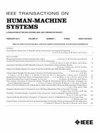在 BMI 神经肌肉刺激过程中跟踪等长握力的状态空间控制方法
IF 4.4
3区 计算机科学
Q2 COMPUTER SCIENCE, ARTIFICIAL INTELLIGENCE
引用次数: 0
摘要
老年人60%的手部运动涉及抓握,这就是为什么抓握恢复是上肢康复治疗的主要组成部分。神经肌肉电刺激在辅助抓取方面是有效的,但围绕患者参与和控制的挑战,以及由于疲劳和肌肉非线性导致的不良运动调节继续阻碍其在临床应用中的采用。在这项研究中,我们将基于脑电图的脑机接口(BMI)与闭环神经肌肉刺激相结合,通过等长力跟踪任务来恢复抓取并评估其性能。经过3次实验,我们得出结论:采用状态空间反馈控制器进行闭环刺激时的归一化跟踪误差(25±15%)明显小于常规开环刺激时的归一化跟踪误差(31±24%)(F (748.03, 1) = 23.22, p < 0.001)。此外,受损研究参与者的BMI分类准确率为65±10%,而健全参与者的BMI分类准确率为57±18%,这表明所提出的闭环系统更能吸引患者进行康复。这些发现证明了基于模型的反馈控制刺激的多会话性能,而不需要频繁的重新配置。本文章由计算机程序翻译,如有差异,请以英文原文为准。
A State-Space Control Approach for Tracking Isometric Grip Force During BMI Enabled Neuromuscular Stimulation
Sixty percent of elderly hand movements involve grasping, which is unarguably why grasp restoration is a major component of upper-limb rehabilitation therapy. Neuromuscular electrical stimulation is effective in assisting grasping, but challenges around patient engagement and control, as well as poor movement regulation due to fatigue and muscle nonlinearity continue to hinder its adoption for clinical applications. In this study, we integrate an electroencephalography-based brain–machine interface (BMI) with closed-loop neuromuscular stimulation to restore grasping and evaluate its performance using an isometric force tracking task. After three sessions, it was concluded that the normalized tracking error during closed-loop stimulation using a state-space feedback controller (25 ± 15%), was significantly smaller than conventional open-loop stimulation (31 ± 24%), (
F
(748.03, 1) = 23.22,
p
< 0.001). Also, the impaired study participants were able to achieve a BMI classification accuracy of 65 ± 10% while able-bodied participants achieved 57 ± 18% accuracy, which suggests the proposed closed-loop system is more capable of engaging patients for rehabilitation. These findings demonstrate the multisession performance of model-based feedback-controlled stimulation, without requiring frequent reconfiguration.
求助全文
通过发布文献求助,成功后即可免费获取论文全文。
去求助
来源期刊

IEEE Transactions on Human-Machine Systems
COMPUTER SCIENCE, ARTIFICIAL INTELLIGENCE-COMPUTER SCIENCE, CYBERNETICS
CiteScore
7.10
自引率
11.10%
发文量
136
期刊介绍:
The scope of the IEEE Transactions on Human-Machine Systems includes the fields of human machine systems. It covers human systems and human organizational interactions including cognitive ergonomics, system test and evaluation, and human information processing concerns in systems and organizations.
 求助内容:
求助内容: 应助结果提醒方式:
应助结果提醒方式:


